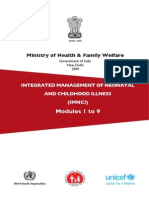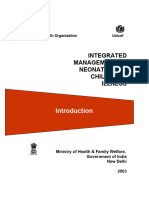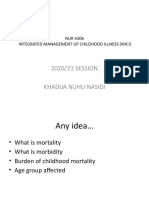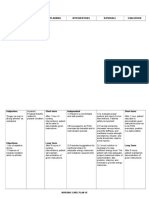Imnci
Imnci
Uploaded by
Swati LalCopyright:
Available Formats
Imnci
Imnci
Uploaded by
Swati LalOriginal Title
Copyright
Available Formats
Share this document
Did you find this document useful?
Is this content inappropriate?
Copyright:
Available Formats
Imnci
Imnci
Uploaded by
Swati LalCopyright:
Available Formats
IMNCI
Introduction
Integrated Management of Childhood Illness (IMCI) strategy, developed by World Health
Organization in collaboration with UNICEF and many other agencies in mid 1990s, combines
improved management of common childhood illnesses with prevention of diseases and
promotion of health by including counseling on feeding and immunization. This strategy has
been adapted and expanded in India to include neonatal care at home as well as in the health
facilities and renamed as Integrated Management of Neonatal and Childhood Illness (IMNCI).
Objective
To reduce under five morbidity and mortality in the developing countries in the developing
countries by improved performance of health workers.
Principles
The IMNCI guidelines are based on the following principles:
All children under 5 yr of age must be examined for conditions which indicate immediate
referral
Children must be routinely assessed for major symptoms, nutritional and immunization
status, feeding problems and other problems
Only a limited number of carefully selected clinical signs are used for assessment
A combination of individual signs is used to classify the severity of illness which calls for
specific action rather than a 'diagnosis'. Classifications are color coded and suggest
referral (pink), initiation of treatment in health facility (yellow) or management at home
(green)
IMNCI guidelines address most common, but not all pediatric problems
IMNCI management protocols use a limited number of essential drugs
Caretakers are actively involved in the treatment of children
IMNCI includes counseling of caretakers about home care including feeding, fluids and
when to return to health facility.
Components
The IMNCI strategy includes both preventive and curative interventions that aim to improve
practices in health facilities, the health system and at home.
The strategy includes three main components:
i. Improvements in the case management skills of health staff through use of locally adapted
guidelines
ii. Provision of essential drug supplies
iii. Optimization of family and community practices in relation to child health.
Sets of charts
Depending on a child's age, various clinical signs and symptoms differ in their degrees of
reliability and diagnostic value and importance. IMNCI clinical guidelines focus on children up
to 5 year of age. The treatment guidelines have been broadly described under two age categories:
l. Young infants age up to 2 months
2. Children age 2 months up to 5 year
Process
Steps of case management process are:
Step 1: Assess the young infant/child
Step 2: Classify the illness
Step 3: Identify treatment
Step 4: Treat the young infant/ child
Step 5: Counsel the mother
Step 6: Follow up care
Advantages of integrated approach
• Speeds up the urgent treatment and treatment seeking practices.
• Prompt recognition of serious condition, hence prompt referral.
• Involves parents in effective care of baby at home.
• Partial Success of Individual disease control programme.
• Involves prevention of diseases by active immunization, Improved nutrition and Exclusive
Breastfeeding practices.
• Highly cost effective.
• It avoids wastages of resources by using most appropriate medicines and treatment.
• It reduces duplication of effort.
You might also like
- Ratio Preboard 1 NP 1 IntensiveDocument10 pagesRatio Preboard 1 NP 1 IntensiveKonstantin Konstantius75% (4)
- EPI - AND - IMCI - Docx Filename - UTF-8''EPI AND IMCIDocument14 pagesEPI - AND - IMCI - Docx Filename - UTF-8''EPI AND IMCIYvonne Carmel Aguilar SunigaNo ratings yet
- CHN 211 Week 8 PPT - Integrated Management of Childhood IllnessDocument82 pagesCHN 211 Week 8 PPT - Integrated Management of Childhood IllnessMark Angelo Berdejo100% (1)
- IMCI - Integrated Management of Childhood IllnessDocument11 pagesIMCI - Integrated Management of Childhood IllnessIvy100% (2)
- IMCI IntroductionDocument7 pagesIMCI IntroductionVanessa MendezNo ratings yet
- Integrated Management of Childhood Illness (Course Audit)Document285 pagesIntegrated Management of Childhood Illness (Course Audit)MOHAMMAD IBRAHIM AGORNo ratings yet
- IMNCI Training Module 1-9Document356 pagesIMNCI Training Module 1-9smbawasaini60% (5)
- IMNCI COMBINED + AdolescenceDocument82 pagesIMNCI COMBINED + AdolescenceibegbunamchinemeremNo ratings yet
- Integrated Management of Childhood IllnessDocument83 pagesIntegrated Management of Childhood Illnessjava_biscocho1229No ratings yet
- Module 1Document16 pagesModule 1devikanika02No ratings yet
- Integrated Management of Childhood IllnessDocument18 pagesIntegrated Management of Childhood IllnessRika Mae100% (1)
- Imnci StrategiesDocument21 pagesImnci Strategiesshahaman1948No ratings yet
- Integrated Management of Childhood IllnessDocument5 pagesIntegrated Management of Childhood Illnessjulieyauder624No ratings yet
- Seminar On IMNCI (Autosaved)Document17 pagesSeminar On IMNCI (Autosaved)CM-A-12-Aditya Bhopalbade100% (3)
- 7091371954mod 1 INTRODUCTION RDocument16 pages7091371954mod 1 INTRODUCTION RJEEJANo ratings yet
- Weekly Activity Midterm CHN (Vivas, Mariah Jamby A. BSN-II)Document5 pagesWeekly Activity Midterm CHN (Vivas, Mariah Jamby A. BSN-II)Mariah VivasNo ratings yet
- SEMINAR ON ImnciDocument8 pagesSEMINAR ON Imncivineeta.ashoknagar100% (1)
- 1 IMCI IntroductionDocument13 pages1 IMCI IntroductionESTE CRECIA EDULLANTES BULLECERNo ratings yet
- Integrated Management of Childhood Illness (IMCI)Document48 pagesIntegrated Management of Childhood Illness (IMCI)Ram krishnaNo ratings yet
- By: 1. Alaa Yousif Dafalla 2. Reham Hamad Mohamed 3. Abubaker Mahmoud MohamedDocument31 pagesBy: 1. Alaa Yousif Dafalla 2. Reham Hamad Mohamed 3. Abubaker Mahmoud MohamedAhmed AlbagerNo ratings yet
- IMCIDocument24 pagesIMCISaniNo ratings yet
- DOH ProgramsDocument2 pagesDOH Programscorpuzdarryl3No ratings yet
- Pediatric Revieer PrelimsDocument3 pagesPediatric Revieer PrelimsJada GonzalesNo ratings yet
- Integrated Management of Childhood Illness IntroductionDocument27 pagesIntegrated Management of Childhood Illness IntroductionKevin LockwoodNo ratings yet
- Maternal Lab 1Document2 pagesMaternal Lab 1Kinday DaganosNo ratings yet
- Integrated Management of Childhood Illness (IMCI) A Strategy, An ApproachDocument23 pagesIntegrated Management of Childhood Illness (IMCI) A Strategy, An ApproachMarjo FegideroNo ratings yet
- Integrated Management of Childhood IllnessDocument3 pagesIntegrated Management of Childhood IllnessJanine Alexis BuenviajeNo ratings yet
- INTEGRATED MANAGEMENT OF NEONATE AND CHILDHOOD ILLNESS (Repaired)Document13 pagesINTEGRATED MANAGEMENT OF NEONATE AND CHILDHOOD ILLNESS (Repaired)Archana Sahu100% (2)
- Integrated Management of Childhood IllnessesDocument27 pagesIntegrated Management of Childhood IllnessesJoeYeshitellaNo ratings yet
- Integrated Management On Childhood IllnessDocument3 pagesIntegrated Management On Childhood IllnessAbeer AguamNo ratings yet
- Doh Health Programs 1Document139 pagesDoh Health Programs 1Eric VeranoNo ratings yet
- IMCIDocument2 pagesIMCIKit BarcelonaNo ratings yet
- Imnci IntroDocument31 pagesImnci IntroSakthi DeviNo ratings yet
- MCN Lecture NotesDocument52 pagesMCN Lecture NotesJHYANE KYLA TRILLESNo ratings yet
- Integrated Management of Childhood IllnessDocument8 pagesIntegrated Management of Childhood IllnessSehar162No ratings yet
- 1-Imci 48Document48 pages1-Imci 48Abdikadir MohamedNo ratings yet
- Pedia ImciDocument2 pagesPedia ImciWispy NotesNo ratings yet
- Integrated Management of Childhood IllnessDocument2 pagesIntegrated Management of Childhood Illness지창욱No ratings yet
- Lesson Plan ImnciDocument8 pagesLesson Plan ImnciBhardwaj Lokesh67% (3)
- IMNCIDocument31 pagesIMNCIJaya Prabha100% (2)
- Integrated Management of Childhood IllnessDocument13 pagesIntegrated Management of Childhood IllnessRachelle Gay PacialNo ratings yet
- Integrated Management of Neonatal and Childhood Illness Strategy An Approach For Hypothermia in NewbornsDocument5 pagesIntegrated Management of Neonatal and Childhood Illness Strategy An Approach For Hypothermia in NewbornsEditor IJTSRDNo ratings yet
- Integrated Management of Childhood IllnessDocument5 pagesIntegrated Management of Childhood IllnessheartianeNo ratings yet
- About Integrated Management of Childhood IllnessDocument5 pagesAbout Integrated Management of Childhood IllnessRouena Santiago VillaramaNo ratings yet
- IMCI (Integrated Management of Childhood Illness)Document4 pagesIMCI (Integrated Management of Childhood Illness)Jane BautistaNo ratings yet
- Why Do We Need To Adopt The I.M.C.I. Approach or The Integrated Management of Childhood Illness in The Philippines ?Document15 pagesWhy Do We Need To Adopt The I.M.C.I. Approach or The Integrated Management of Childhood Illness in The Philippines ?Mae DoctoleroNo ratings yet
- IMCIDocument11 pagesIMCIJoshua Villarba100% (1)
- IMCI Integrated Management of Childhood IllnessDocument24 pagesIMCI Integrated Management of Childhood Illnesssimplyme_tin13100% (1)
- In The Pre-Hospital SettingDocument13 pagesIn The Pre-Hospital SettingMichael VillavertNo ratings yet
- Planning of Individual and Family Health Nursing Care: Montibon Edelainne Joyce B Pila, Liza Aingelica BDocument25 pagesPlanning of Individual and Family Health Nursing Care: Montibon Edelainne Joyce B Pila, Liza Aingelica BLiza AingelicaNo ratings yet
- Imci, Diseases With TreatmentDocument54 pagesImci, Diseases With TreatmentBernadeth Tolentino LimonNo ratings yet
- Imnci: (Principles and Strategies)Document15 pagesImnci: (Principles and Strategies)Dhanunjay Kalvakuri NaiduNo ratings yet
- 14 ImciDocument8 pages14 ImciDawit g/kidanNo ratings yet
- Report of Inservice EducationDocument35 pagesReport of Inservice EducationAkansha JohnNo ratings yet
- IMNCIDocument36 pagesIMNCIVenkat PerumalsamyNo ratings yet
- The Integrated Management of Childhood IllnessDocument2 pagesThe Integrated Management of Childhood IllnessElvira GumiNo ratings yet
- Febrile Illness 2019 Shamim QaziDocument27 pagesFebrile Illness 2019 Shamim QaziAbdi TofikNo ratings yet
- Integrated Management of Childhood Illness (Document4 pagesIntegrated Management of Childhood Illness (Kenric DavidNo ratings yet
- 5-Child Guidance ClinicsDocument13 pages5-Child Guidance ClinicsSwati LalNo ratings yet
- Swati ResumeDocument3 pagesSwati ResumeSwati LalNo ratings yet
- 5-Child Guidance ClinicsDocument4 pages5-Child Guidance ClinicsSwati LalNo ratings yet
- 3-mx of Challenged ChildrenDocument6 pages3-mx of Challenged ChildrenSwati LalNo ratings yet
- English GNM Question PaperDocument1 pageEnglish GNM Question PaperSwati LalNo ratings yet
- Thesis StatementDocument3 pagesThesis Statementapi-301334682No ratings yet
- Neurolinguistic Programming. A Systematic Review.Document8 pagesNeurolinguistic Programming. A Systematic Review.José Inés Bazán MotaNo ratings yet
- Impaired Physical MobilityDocument3 pagesImpaired Physical MobilityStar AlvarezNo ratings yet
- Forensic Pharmacy & Forensic PharmacistDocument2 pagesForensic Pharmacy & Forensic Pharmacistnawabmg3No ratings yet
- PressRelease DKSH Expands Partnership With Bioderma v5 PDFDocument4 pagesPressRelease DKSH Expands Partnership With Bioderma v5 PDFGrigore Iulia0% (1)
- Donna Shoupe: EditorDocument1,112 pagesDonna Shoupe: Editordr Farah Imad Ali100% (1)
- Clinical Teaching ON Geriatric AssessmentDocument9 pagesClinical Teaching ON Geriatric AssessmentANITTA SNo ratings yet
- Algoritmo Via AereaDocument9 pagesAlgoritmo Via AereaIrene Cristina100% (2)
- Stress FNCPDocument2 pagesStress FNCPbarrerafrancheskadeniseNo ratings yet
- Disease The British Journal of Diabetes & VascularDocument6 pagesDisease The British Journal of Diabetes & VascularEstiPramestiningtyasNo ratings yet
- Score Predicting The Need For Hospitalization in Scorpion EnvenomationDocument7 pagesScore Predicting The Need For Hospitalization in Scorpion EnvenomationWalaa YousefNo ratings yet
- Pregnant Women Attending Antenatal Care and First Antenatal Care Visit in EthiopiaDocument8 pagesPregnant Women Attending Antenatal Care and First Antenatal Care Visit in EthiopiaAbu HajerahNo ratings yet
- FMS 006-Medical Equipment Management ProgramDocument4 pagesFMS 006-Medical Equipment Management ProgramMohamed AttiaNo ratings yet
- Medical ConsultantDocument4 pagesMedical Consultantapi-121402637No ratings yet
- BSN Curriculum Grid IncomingDocument1 pageBSN Curriculum Grid IncomingKatie Roy100% (2)
- HHS Public AccessDocument28 pagesHHS Public AccessBea Barbara CarrascalNo ratings yet
- Psychology Research PaperDocument15 pagesPsychology Research Paperapi-509267463No ratings yet
- Dog EssayDocument7 pagesDog Essayapi-509619698No ratings yet
- Diabetes Education and Support: A Must For Students With DiabetesDocument2 pagesDiabetes Education and Support: A Must For Students With DiabetesKritik KumarNo ratings yet
- PG Diploma Courses TamilnaduDocument14 pagesPG Diploma Courses TamilnaduDENTALORG.COM100% (2)
- Pocket Guide To Clinical Examination (Pocket Guide To... (Mosby) ) - 4th Edition. ISBN 0723434654, 978-0723434658Document23 pagesPocket Guide To Clinical Examination (Pocket Guide To... (Mosby) ) - 4th Edition. ISBN 0723434654, 978-0723434658ronasalvidortbk89% (9)
- Prof Ad Chapter 1: Nursing As A ProfessionDocument11 pagesProf Ad Chapter 1: Nursing As A ProfessionJulia Mariz BadicNo ratings yet
- Preventive Medicine Part IaDocument4 pagesPreventive Medicine Part IarustonNo ratings yet
- Liberia - National Policy and Strategic Plan On Health Promotion, 2016 - 2021Document44 pagesLiberia - National Policy and Strategic Plan On Health Promotion, 2016 - 2021Rémi DANHOUNDONo ratings yet
- All Progressive Circle Wise & Cadar Wise Summery Status 01-03-2024Document25 pagesAll Progressive Circle Wise & Cadar Wise Summery Status 01-03-2024vivekNo ratings yet
- Siap Print Untuk SimulasiDocument3 pagesSiap Print Untuk SimulasiRossa patria NandaNo ratings yet
- AclsDocument13 pagesAclsAllah YarNo ratings yet
- Mortality, Dying and Death: Global Interdisciplinary PerspectivesDocument384 pagesMortality, Dying and Death: Global Interdisciplinary PerspectivesBloomNo ratings yet
- Definition of Terms Purposes of Documentation in The Nursing Practice 1. CommunicationDocument37 pagesDefinition of Terms Purposes of Documentation in The Nursing Practice 1. CommunicationMARIA STEPHANY DELA CRUZNo ratings yet






























































































